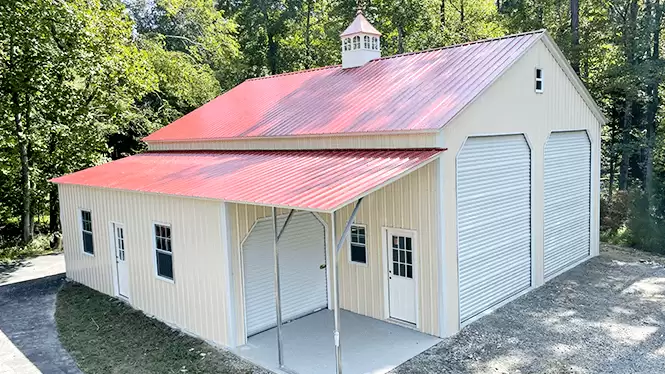Up, Down, or Sideways?
When designing your metal building, you’ll have a wide range of customization options to choose from. This customizability will allow you to change and upgrade almost every aspect of your building to suit your needs. One of the customizations you’ll come across during this process will involve your metal buildings roof.
In most cases, you’ll have the choice between horizontal roofs and vertical roofs. Aside from aesthetics, there are several reasons why your decision might come down to more than just looks.
In this blog, we’ll compare horizontal and vertical roof buildings and provide you with information that can help you make the right purchase for your needs, climate, and budget.
Horizontal or Vertical Roof Buildings? Which is Better for You?
Selecting the right roofing style is a crucial decision that will significantly affect both the aesthetics and functionality of your metal building. Let’s delve deeper into each roofing type to help you make an informed choice:
A-frame Horizontal Roofing
An A-frame horizontal roof building features a roof very similar to one you’d find on a traditional home, with a sharper roof peak, and overhanging awnings, or eaves. This roof is comprised of steel paneling arranged horizontally, providing your structure with greater strength and stability compared to other roofing options.
Benefits:
- Cost-Effective
A-frame horizontal roofing is often more budget-friendly than its vertical counterpart. If you’re working within a tight budget, this option can offer significant savings, making it an attractive choice for many.
- Ease of Installation
The installation process for horizontal roofs is generally straightforward, contributing to lower labor costs and faster construction times. This makes it a practical choice for those looking to complete their metal building project efficiently.
Downsides:
- Water Drainage
The only downside of horizontal roofing lies in its potential water drainage. In areas with heavy precipitation, water, snow, or debris might accumulate.
Vertical Roofing
Much like horizontal roofs, vertical roofing will feature a sharper roof pitch and overhanging awnings but with vertically arranged panels. These vertical panels make channels for water, snow, leaves, and storm debris to slide harmlessly away from your structure.
Benefits:
- Superior Water Runoff
One of the standout advantages of vertical roofing is its superior water runoff capability. The perpendicular orientation of the panels allows for efficient drainage, making it an ideal choice for areas with heavy rain or snowfall. This feature minimizes the risk of leaks and water-related damage.
- Enhanced Durability
Vertical roofs are renowned for their durability and strength. This design is particularly effective in withstanding harsh weather conditions, including heavy snow loads and high winds.
Downsides:
- Higher Cost
Metal building prices are often higher with vertical roofing compared to their horizontal counterparts. However, many find that the added expense is justified by the increased durability and superior performance in challenging weather conditions.
Critical Factors to Consider When Choosing the Roof Style for Your Metal Building
So, which roofing style is best for you? Let’s break down what you should be looking for in a metal building roof:
1. Slope
The slope or pitch of your roof is a factor that can influence the choice between horizontal and vertical roofing. A-frame horizontal roofs are suitable for moderate slopes, providing effective water runoff. On the other hand, vertical roofs are more versatile and can accommodate steeper slopes, ensuring efficient drainage even in areas prone to heavy precipitation.
2. Location and Climate
Consider the geographical location and climate conditions of the area where your metal building will be situated. In regions with frequent rain, snow, or storms, vertical roofs are often recommended. Their superior water runoff capabilities make them well-suited for areas with challenging weather conditions.
3. Paneling Gauge
The thickness of the metal panels is a crucial factor affecting the durability and strength of your metal building. In most cases, roofs are created using 26-gauge steel. But if you live in a region with high winds and heavy snow accumulation, you’ll likely need to upgrade to thicker 24-gauge steel.
4. Aesthetics
Consider the visual impact of both horizontal and vertical roof styles. A-frame horizontal roofs may lend a traditional and familiar appearance, suitable for a variety of settings. Vertical roofs, with their clean lines and modern look, can provide a more contemporary and commercial aesthetic.
Make the Right Decision with Boss Buildings
Whether you’re searching for DIY metal building kits for your backyard or looking for the right metal building for sale to house your commercial facility, Boss Buildings is proud to be your premier choice for all things metal buildings. Our structures are designed using modern engineering techniques, and built with years of dedication and experience.
Call Boss Buildings today at (336) 673-3065 and speak with one of our building experts. We’ll guide you through the process, help you choose the right roof and accessories, and deliver a building that will stand strong for years to come. Because when the Boss is on the job, you know it’s done right.


